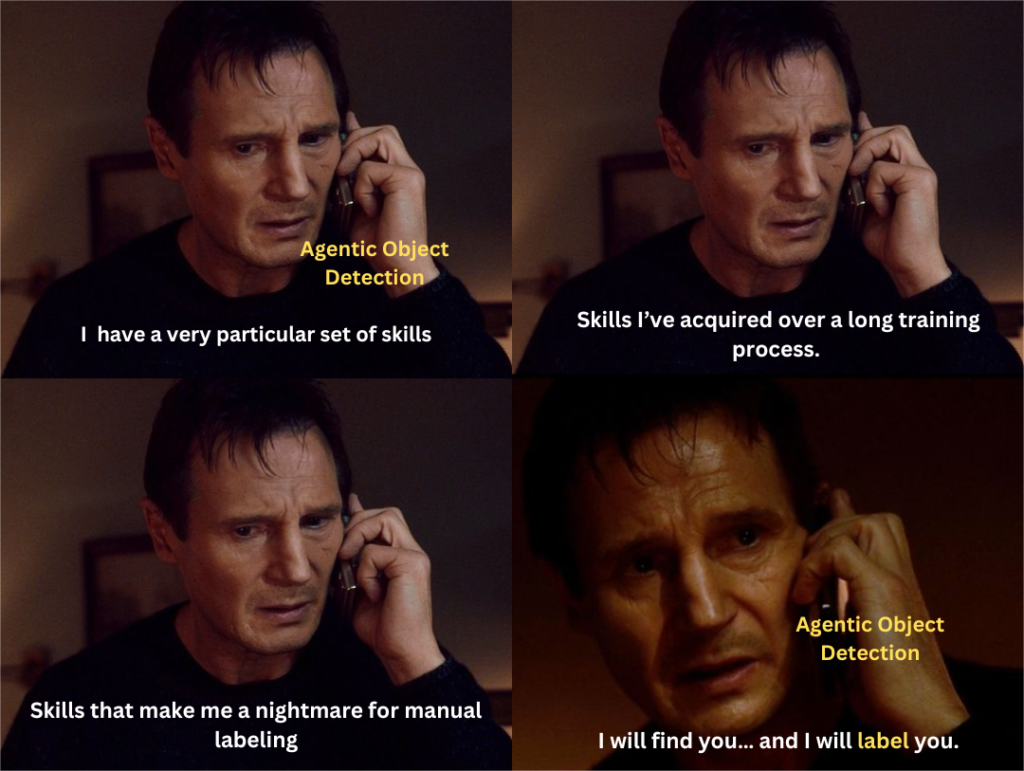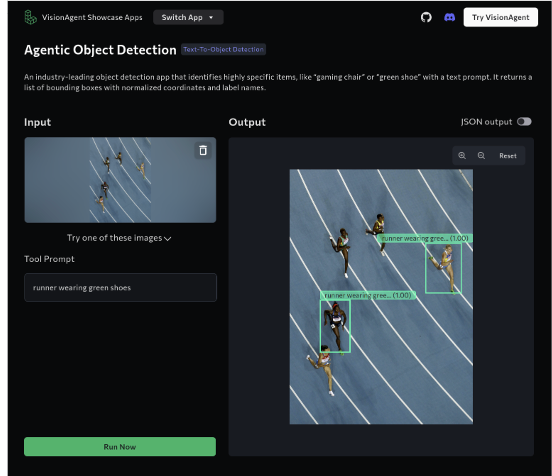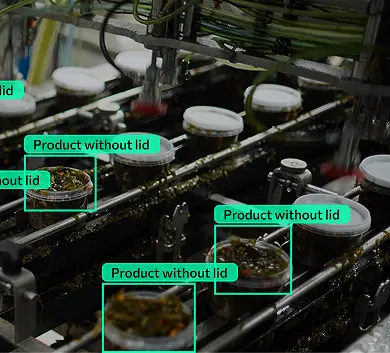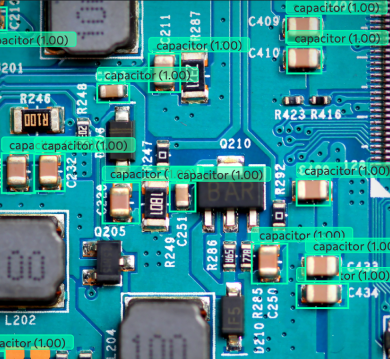Teaching AI to recognize objects can occasionally be a slow, frustrating, and expensive process. Imagine going through thousands of images and marking every single object by hand just so the AI knows what to look for. This can take months and cost companies quite a lot.
And after all that effort, the AI model still struggles. It gets confused when objects overlap, when lighting is bad, or when something looks a little different from what it has seen before. In places like hospitals and warehouses, these mistakes can lead to serious problems.
Agentic object detection changes this. No more manual labeling. No more wasted time. Just tell the AI what to find in plain language, and it figures out the rest using reasoning and context.

In this blog, we will explore how it works, how it stacks up against older methods, and how it is already making an impact in the real world.
What Is Agentic Object Detection?
AI detects objects by making educated guesses based on past training. It works well for simple tasks but fails when objects overlap, the lighting is terrible, or the scene is complex. Agentic object detection changes this. Instead of just spotting shapes, it reasons through what it sees. It understands relationships, adapts to new environments, and makes more intelligent decisions.

For years, people had to spend weeks labeling thousands of images. They clicked and marked every object by hand, a slow and exhausting process. Now, they do not have to struggle. They just describe what they need, and the AI model figures it out.
It works in three ways. It processes natural language prompts, understands both text and images, and uses a team of models that focus on details like texture and position.
Andrew Ng’s Landing AI built this technology on top of tools like LandingLens, allowing businesses to use AI without the burden of manual labeling.
Breaking Down the Unique Capabilities
Agentic object detection is an AI innovation that is much closer to truly understanding what it sees. It does not just recognize objects; it reasons, adapts, and makes smart decisions. Here is what makes it different.
No More Manual Labeling
Labeling thousands of images has always been slow and frustrating. Most AI models need large datasets with human-marked objects to learn. This one skips that step entirely.

Other models still need partial labeling. Agentic object detection works right away, cutting setup time. That means teams can focus on real work instead of spending weeks preparing data.
Thinking Before Detecting
Most AI models memorize patterns without understanding context. This one thinks before making a decision. It does not just detect a person mid-air and assume they are floating. It considers motion, background, and surroundings.
That means fewer mistakes in complex scenes. It will not misidentify a statue as a person or mistake a dog’s reflection for a second dog.
Adapts to Any Scene
Real-world environments are unpredictable. This AI adapts instead of freezing when things get messy.
It can tell ripe fruit from unripe fruit, recognize branded drinks in a cluttered fridge, and detect moving objects without confusion. Unlike older models, it does not rely on perfectly clean images to work.
Teamwork Between AI Models
Instead of one AI model trying to do everything, multiple specialized models work together. Each one handles a different task. One detects textures, another identifies object positions, and another understands the background.
If you ask it to find a daisy on top of ice cream, one model spots the flower, another checks textures, and another figures out which object is on top. This collaborative approach improves accuracy.
How Agentic Object Detection Outpaces the Competition
Accuracy is what sets agentic object detection apart. In traditional object detection, where AI models must identify objects beyond its training data, it delivers nearly double the accuracy of its closest competitors.
Here are the benchmark results:
- LandingAI Agentic: 79.7%
- Microsoft Florence-2: 39.7%
- Google OWLv2 43.2%
- Alibaba Qwen2.5-VL-7B – 35.1%
For industries where precision is critical, these numbers speak for themselves.
Trade-Offs
Precision comes at a cost. Landing AI’s Agentic Object Detection takes 20-30 seconds per image, which is slower than other models. But in high-stakes applications like healthcare, manufacturing, and logistics, accuracy matters more than speed.

Other systems process images faster, but they make more mistakes. In industries where one wrong detection can lead to major consequences, getting it right is far more important than getting it done fast.
High-Stakes Use Cases
Agentic object detection has the potential to transform various industries by enhancing precision and efficiency. Here are three specific applications:
Assembly Verification in Manufacturing
In manufacturing, every component must be correctly placed for a product to function properly. Even a small misalignment of a capacitor or screw can lead to defects, recalls, or equipment failure. Common inspection systems often struggle with overlapping parts or variations in lighting, leading to errors.
Agentic object detection improves accuracy by identifying specific components in complex assemblies. It analyzes spatial positioning, texture, and context to ensure each part is in the right place. This helps manufacturers reduce errors, improve quality control, and prevent costly production issues.
Defect Detection in Semiconductor Production
The semiconductor industry requires extreme precision. Micro-defects on wafers or circuit boards can impact device performance, yet these defects are often too small for traditional vision systems to detect reliably. Existing AI models frequently misidentify minor scratches or dust as defects, leading to false positives.
With reflective reasoning and multi-agent collaboration, Agentic object detection can differentiate between actual defects and harmless variations.
It assesses texture, depth, and positioning, allowing semiconductor manufacturers to detect defects with far greater accuracy. This minimizes waste, increases yield, and improves efficiency in chip production.
Pharmaceutical Industry: Detecting Empty Blister Packs
In pharmaceuticals, every pill or tablet in a blister pack must be present to meet safety and compliance standards. Traditional object detection systems rely on fixed patterns and struggle when packaging changes or lighting conditions vary.
Agentic object detection analyzes both shape and context to ensure that every slot is filled correctly. It detects missing pills, misaligned packaging, or damaged compartments in real time.
This allows pharmaceutical companies to take immediate corrective action, ensuring only correctly filled packages reach consumers.
Challenges: Addressing the Trade-Offs
Every new technology has its challenges, and agentic object detection is no different. While it delivers high accuracy, there are a few things that need to be improved. Here are some of the key challenges and how they are being addressed.
- Processing Speed: Right now, it takes 20–30 seconds per image, which is slower than other models. This makes real-time use difficult. Optimizing how the AI processes images and using edge computing can help speed things up.
- Scalability: Because the AI thinks through what it sees, it needs a lot of computing power, which can be expensive. Improving model efficiency and deployment strategies will help reduce these costs.
- Adaptability to Novel Situations: Agentic AI models can struggle with unseen objects or environments, limiting their generalization. Continual learning and reinforcement learning methods can help the model adapt over time without requiring a full retraining process.
Tools and Support for Developers
Agentic object detection provides multiple ways for developers to integrate it into their systems. It supports Python SDKs, REST, and GraphQL, allowing for flexible implementation across different platforms without requiring advanced AI expertise.
To speed up deployment, developers can access pre-trained models in the VisionAgent model zoo instead of training models from scratch. This reduces setup time and simplifies the process.
For troubleshooting and knowledge sharing, the VisionAgent Discord community has 10,000+ members discussing use cases, exchanging insights, and helping each other solve technical challenges.
Key Takeaways
Agentic Object Detection removes the need for manual labeling and understands objects through natural language prompts. It does more than just detect shapes. It thinks through what it sees, which helps it work better in complex situations.
The technology is still in its early stages and has some limitations that need to be addressed before it can reach its full potential. As improvements in efficiency and scalability continue, it could unlock even more possibilities in the future.
This article was contributed to the Scribe of AI blog by Aakash R.
At Scribe of AI, we spend day in and day out creating content to push traffic to your AI company’s website and educate your audience on all things AI. This is a space for our writers to have a little creative freedom and show-off their personalities. If you would like to see what we do during our 9 to 5, please check out our services.



